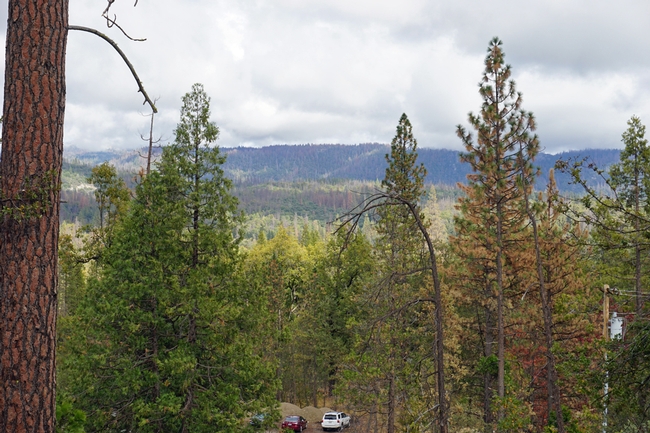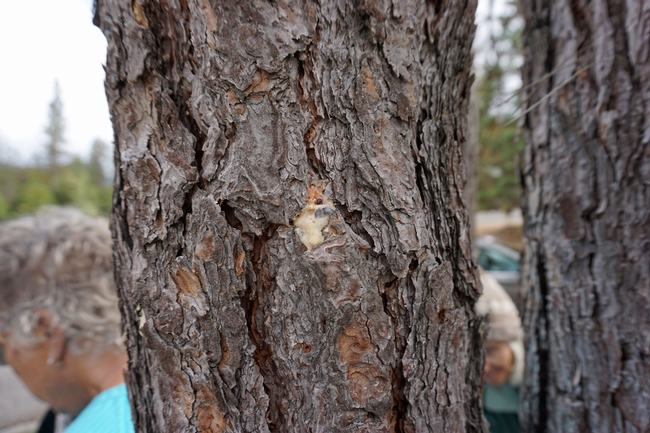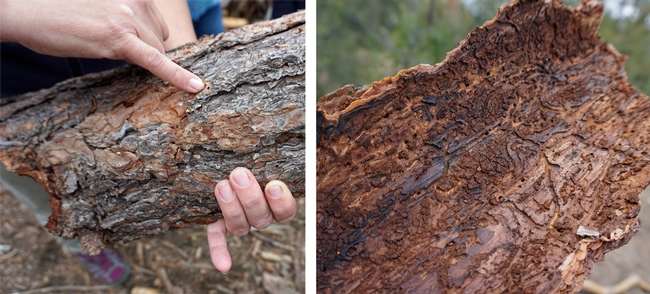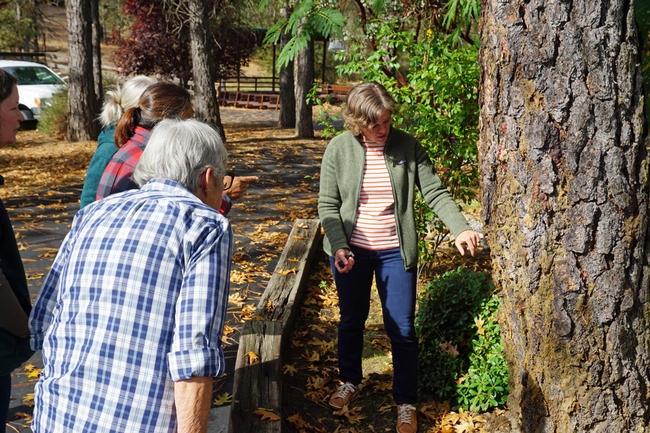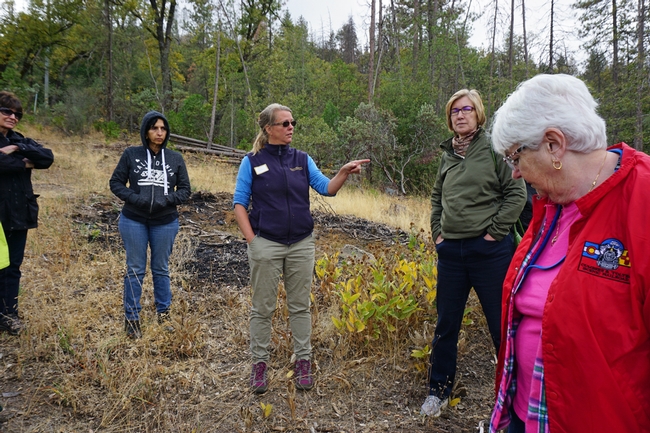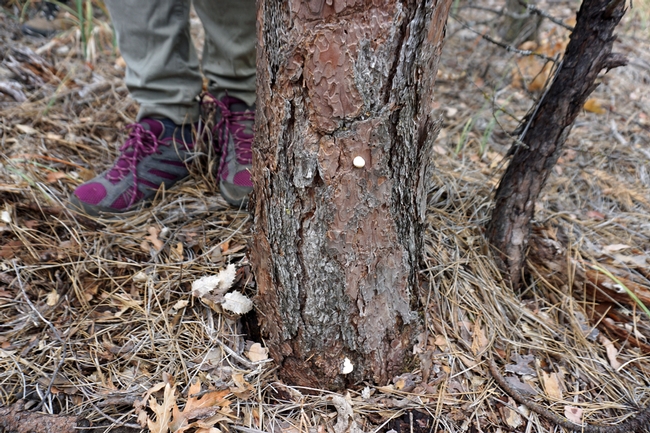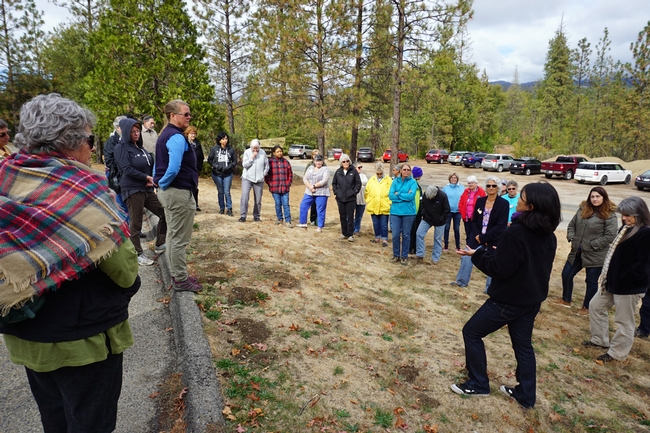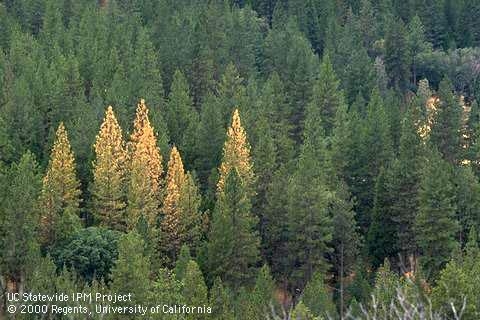Posts Tagged: Beetles
Replanting the Sierra Nevada after an ecological catastrophe
Given California's changing climate, should Sierra Nevada residents replant pine trees after so many died during the 2010-2016 drought? The short answer is yes, says Susie Kocher, UC Cooperative Extension forestry advisor.
“We have every reason to believe that pines will continue to be an important part of mixed conifer forests in the Sierras,” Kocher said.
Kocher spoke at a meeting for UC Master Gardeners, volunteers who provide landscape advice to the public in California. Questions have been coming in to Master Gardener hotlines from mountain residents wondering what to do after unprecedented tree loses in the last few years.
Most California forests are suffering from severe overcrowding due to 100 years of aggressive fire suppression and selective harvesting of the largest and most resilient trees. They were then subjected to five years of drought.
“There were just too many stems in the ground,” Kocher said. “The drought was very warm, so trees needed more water, but got less. These were optimal conditions for bark beetles.”
Western pine beetle is a native pest that attacks larger ponderosa pine and Coulter pine trees weakened by disease, fire, injury or water stress. Bark beetles are tree species specific, so other beetles target other species of trees in California's mixed conifer forests. Typically, bark beetles bore through tree bark and create long winding tunnels in the phloem. An aggregating pheromone attracts additional bark beetles to the tree, and heavily attacked trees invariably die.
During the drought, 102 million Sierra Nevada trees died from bark beetle attack or simply lack of water; 68 million of those died in 2016 alone. But after the abundant rainfall in the 2016-17 season, the bark beetle population seems to have crashed.
Landowners with 20 acres or more may be eligible for a state cost-sharing program to remove trees, reduce the fire hazard and replant new seedlings. Landowners in mountain communities who wish to revitalize their properties can contact local UC Master Gardeners for recovery advice.
UC Master Gardeners are plant enthusiasts who have passed an intense training program presented by UC academics. They participate in continuing education annually to update and maintain their knowledge. More than 60 Master Gardeners from Mariposa, Madera and Fresno counties gathered in Oakhurst in October to learn from UC scientists how to work with mountain homeowners whose towering trees have died. Similar training sessions, all funded by a grant from UC Agriculture and Natural Resources, were held in El Dorado and Tuolumne counties in June.
“There is life after beetles,” said Jodi Axelson, UC Cooperative Extension forestry specialist at UC Berkeley.
“Eco systems are stretched, and then they come back,” she said. “You must remember the time scale of forest change is long and pines have been a major species in the Sierra Nevada for at least 28,000 years. As long as there have been pines, there have been bark beetles.”
The scientists suggest that people who own forestland take a step back and assess the landscape after their dead trees have been removed.
“We're seeing a lot of young cedar and white fir surviving the drought. Oaks seem to be doing really well,” Kocher said.
She suggests landowners thin young trees so available sun and soil moisture are focused on the healthiest trees. Water seedlings that are receiving more sun than before to reduce stress. Planting native conifers is the best option. Due to climate change, she recommends choosing trees from a slightly lower elevation to hedge against warmer temperatures in the future.
Pines are adapted to the California forest, but may need help to regenerate. When the ground is moist in the late fall or spring, plant seedlings 10 to 14 feet apart. New trees should be planted well away from homes to maintain defensible space and at least 10 feet from power lines.
“Please don't set them up for future torture,” Kocher said. “That's just sad.”
To help the new trees become established, cover the ground around the tree, but not touching the bark, with two or three inches of mulch and irrigate weekly during the dry season for the first few years.
Questions about special circumstances may be directed to local UC Master Gardeners. Find the local program here: http://mg.ucanr.edu/FindUs/
Forest and tree health in a time of drought
The fourth winter in a row of disappointing precipitation has triggered a die off of trees in the Sierra Nevada, most of which is now in ‘exceptional drought' status. The US Forest Service conducted aerial monitoring surveys by airplane in April 2015 and observed a large increase in tree mortality in the Southern Sierra (from Sonora south). Surveyors flew over 4.1 million acres of public and private forest land and found that about 20 percent had tree mortality on it, totaling over 10 million dead trees.
The Forest Service found severe mortality in many pine species especially ponderosa pine. On private lands along the foothills of the Sierras, surveyors found extensive areas of dead pines. Large areas of blue and live oak mortality were also suspected though it was too early in the season to be sure.
On the Stanislaus National Forest, areas with dead trees doubled since last year. Pine mortality, mostly caused by western pine beetle, was common at lower elevations. Over 5 million trees were killed on the Sierra and Sequoia National Forests up from the 300,000 trees killed last year in the same area. Conifer mortality was scattered at higher elevation, though surveyors note that the survey was conducted too early in the year to detect the full extent of mortality levels.
The insects killing trees in the Sierra are all native insects that are multiplying because of drought conditions. Native insects are a necessary part of the forest ecosystem that speed decay of wood back into nutrients, prey on other insects, and provide food for wildlife. They are normally present at low levels and cause tree mortality only in localized areas.
However, drought weakens trees and reduces their ability to withstand insect attacks. Normally trees use pitch to expel beetles that attempt to burrow into the tree through the bark. Weakened trees cannot produce the pitch needed to repel these beetles which are able to enter under the bark and lay eggs. Larvae feed on a tree's inner bark cutting off the tree's ability to transport nutrients and eventually kill it. Attacking beetles release chemicals called pheromones that attract other beetles until a mass attack overcomes the tree. Many beetles also carry fungi that weaken the tree's defenses.
Western pine beetle is one of the main culprits killing pines in the Sierra during this drought. It is a bark beetle, one of a genus of beetles named Dendroctonus which literally means ‘tree-killer'. Adult beetles are dark brown and about a quarter-inch long. Adults bore into ponderosa pines, lay eggs which develop into larvae in the inner bark then complete development in the outer bark. When beetle populations are high, such as during drought periods, even healthy trees may not be able to produce enough pitch to ward off hundreds of beetle attacks.
Western pine beetle often attacks in conjunction with other insects. Other beetles causing tree mortality in Sierra forests include mountain pine beetle, red turpentine beetle, Jeffrey pine beetle, engraver beetles (Ips) and fir engravers. Forests with a higher diversity of tree species are typically less affected because beetles often have a preference for specific tree species. Some species may attack only one tree type. For example Jeffrey pine beetles attack only Jeffrey pine.
The best defense against bark beetles is to keep trees healthy so they are able fight off insects themselves. Widely spaced trees are typically less susceptible to successful attack by bark beetles since they face less competition for moisture, light, and nutrients compared to densely growing and overcrowded trees. Forest health can be promoted by thinning to reduce overcrowding (so each tree has access to more resources) and removing high risk trees during thinning (such as those that are suppressed or unhealthy).
For landscape trees of high value close to a home, watering may be one option to increase tree vigor against bark beetle attacks. Apply about 10 gallons of water for each inch of tree diameter (measured at chest height) around the dripline of the tree once or several times a month during dry weather.
There are some insecticides registered for bark beetle control, but all are preventative only. Carbaryl may prevent attack for up to two years, while pyrethroids can deter attack for up to a year. Spraying can be tricky because the chemical must be applied up to 50 feet up the trunk of the tree usually while standing on the ground. Since misapplication may have toxic consequences, any insecticide must be administered by a licensed pesticide applicator. All applications must follow the label. Though some systemic treatments applied to the soil or inserted into the tree may work in some cases, there is not a lot of documented evidence that they are effective against western pine beetle. No insecticide can prevent tree death once a tree has been successfully attacked.
Author: Susie Kocher, UC Agriculture and Natural Resources Cooperative Extension advisor
Trees dying due to drought are prone to wildfire
Across California, pine trees that have been weakened by the drought are having trouble defending themselves from bark beetles, causing widespread tree death. The dead trees won't cause fires, but when ignited they will be hotter and be more difficult to control, according to articles that ran over the weekend in the Santa Rosa Press-Democrat and the Desert Sun.
“Statewide, it's horrific,” said Greg Giusti, UC ANR Cooperative Extension advisor.
Max Moritz, UC ANR Cooperative Extension specialist in fire ecology, described the combination of exceptionally low vegetation moisture and widespread plant deaths as "a double-barreled threat."
"On top of the dry conditions, it's been unusually hot in many, many parts of the state," Moritz said. "We do have a pretty exceptional fire season stacking up, or the potential for one."
The Los Angeles Times also covered the story earlier this month.
Scott Stephens, fire science professor at UC Berkeley, said fire suppression and harvesting have made forests more dense over the last 100 years. The increased density has made trees more vulnerable as they compete for limited amounts of water, with the weaker trees more susceptible to bark beetle infestations, he said.
“If the drought continues for another two years or longer, I expect this mortality to move throughout the state,” Stephens said. “Forests that once burned frequently with low-moderate intensity fire regimes are the most susceptible.”
Recycling Christmas trees helps curb the spread of pests
If you have a real Christmas tree, University of California pest management experts ask that you to recycle the tree to prevent the spread of insects and diseases that may harm our forests and landscape trees.
“Invasive insects, diseases and plant seeds can move on cut Christmas trees and other holiday greenery,” said Janice Alexander, UC Cooperative Extension forest health educator in Marin County. “These pests can escape out into backyards and neighboring forests to begin new populations, upsetting the balance of our native ecosystems. Proper purchasing and disposal of holiday greenery helps reduce that risk.”
Alexander recommends taking advantage of local tree recycling programs.
“Many municipalities and service organizations offer this service right at your curb,” she said. “If you aren't able to find or use this option, take the tree to your local solid waste facility, dump or landfill. This will keep any pests that might be in the tree from spreading and the landfill uses the material as cover.”
“You should not try to burn the wood indoors as fresh sap can create fire hazards,” she added, “and don't set the tree out in a backyard brush pile where pests and weed seeds could escape onto your property.”
“The most worrisome pests that might be traveling on Christmas trees or greenery this year include P. ramorum, pine shoot beetle and gypsy moth,” Alexander said.
The movement of some fresh trees is regulated. For example, Douglas fir trees are regulated because they are hosts for Phytophthora ramorum, which causes sudden oak death. The disease has killed millions of tanoak trees and several oak tree species in forests throughout California since the mid-1990s.
Pine shoot beetle and gypsy moth are not currently in California, but they could damage the state's Christmas tree plantations and forests if they were to become established.
Pine shoot beetles, Tomicus piniperda, feed on shoots, stunting the growth of pine trees. Large populations of the insects can kill apparently healthy trees.
Gypsy moth, Lymantria dispar, attacks forests and landscape trees, including manzanita, western hemlock, Douglas fir and live oak. Gypsy moth caterpillars feed on hundreds of plant species and are capable of defoliating trees at an alarming rate. A single gypsy moth caterpillar can eat up to one square foot of leaves per day, according to the California Department of Food and Agriculture.
For more information about sudden oak death and forest health, visit Alexander's website at http://cemarin.ucanr.edu/Programs/Custom_Program816. More information about holiday greenery pests can be found at the USDA APHIS website and the Don't Move Firewood website http://www.dontmovefirewood.org/HolidayGreenery.
Lady bugs need special care to control aphids in the garden
Many retail nurseries and garden centers sell lady beetles for controlling aphids in gardens and landscapes. Gardeners often ask, “Does releasing lady beetles really work?”
Lady beetles sold at nurseries for aphid control are convergent lady beetles, named for the converging white marks on its thorax. Suppliers collect beetles from large overwintering aggregations in California's foothills and mountains. Many other species of lady beetles occur naturally in California landscapes but don't aggregate in the mountains and aren't sold commercially.
University of California research has demonstrated that lady beetle releases can effectively control aphids in a limited landscape or garden area if properly handled and applied in sufficient numbers. However, because of inadequate release rates or poor quality, lady beetles often fail to provide satisfactory control. Other low toxicity aphid management practices, such as hosing off or insecticidal soap or oil sprays, may be more effective. Here are some things to consider if you decide to try lady beetle releases:
Lady beetles deteriorate rapidly if not handled properly. Lady beetles need to be kept refrigerated until they are released. Live lady beetles on display in stores are attractive for customers, but beetles left out at room temperature rapidly deteriorate. Also, lady beetles are often dehydrated and need water, especially if they have been held at room temperature, even for a few hours. Stores or gardeners are advised to mist lady beetles with water in a squirt bottle before placing them in the refrigerator for storage, making sure not to let water puddle in containers. When purchasing lady beetles, inspect the container and make sure almost all beetles are alive. Lady beetles purchased from primary suppliers (those who obtain beetles directly from collectors) may be healthier than those held in stores for several weeks.
Use adequate release rates. UC research shows that high numbers of lady beetles are required to control aphids. One large, heavily infested rose bush in the landscape required two applications of about 1,500 lady beetles each, spaced a week apart. Most packages sold in stores contain only enough lady beetles to treat one aphid-infested shrub or a few small plants. Larger qualities can be purchased from online lady beetle suppliers.
Lady beetles need a good supply of aphids. There is no point in releasing them on plants with few aphids. Lady beetles are voracious aphid feeders and an adult beetle will eat 50 or more aphids a day. The convergent lady beetle, which is the species sold for release, feeds almost entirely on aphids and will not remain on plants with low aphid populations and will not control other garden pests.
Release lady beetles at dusk or early evening. Lady beetles will fly away almost immediately if released during the heat of the day or where the sun is shining, so wait until evening to release them. Spray a fine mist of water on the plants before the release. Giving beetles a drink may keep them around longer. Place beetles at the base of plants or in the crotches of low branches. Lady beetles will crawl higher into the plant in search of aphids. Once lady beetles begin to fly, they are likely to fly a substantial distance, often outside the boundaries of your garden. Don't release lady beetles on plants that have been sprayed with insecticides. Residues from most insecticides are likely to kill the beetles. However, insecticidal soaps and oils, once dry, won't leave toxic residues.
Expect lady beetles to fly away in a few days. Even when released with care, lady beetles will fly away within a few days. About 95 percent of released beetles in research studies flew away within 48 hours. The remainder were gone within 4 or 5 days. Lady beetles are unlikely to lay eggs on the plants they are released on. If aphids return a week or two later, gardeners will need to release more lady beetles, hose aphids off with water, use insecticidal soap sprays, or wait for other native aphid natural enemies to fly in.
See the convergent lady beetle page in UC IPM's Natural Enemies Gallery for information about its life cycle and view journal articles about UC research on lady beetle releases for controlling aphids.
This article was modified from the original version published in the June 2011 issue of the Retail Nursery and Garden Center IPM News.

